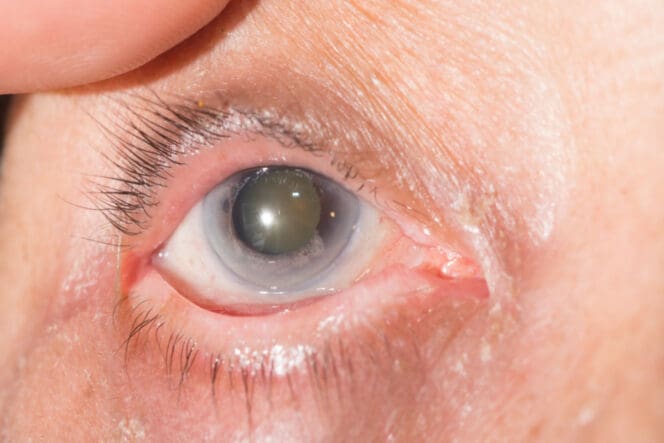A nuclear cataract is the most common type of age-related cataract among older people. It is found more commonly in women, people with brown eyes, people who have myopia, and people with diabetes.
What Is Nuclear Sclerosis?
Nuclear sclerosis is a biochemical change in the proteins in the lens of the eye.
Nuclear refers to the nucleus or center of the lens. This is the most common type of cataract, affecting 24 million people in the United States.
Sclerosis refers to the hardening of the protein in the lens. The biochemical changes cause proteins to harden and clump together, affecting vision. When this becomes severe, it is called a nuclear sclerotic cataract.
The number of people with cataracts is expected to double in the United States. According to the National Eye Institute statistics, by 2050, the number of people affected is expected to go from 24.4 million to about 50 million.
Symptoms of Nuclear Sclerosis

Vision may seem blurry or dimmed. Colors can appear yellow or faded. Some patients compare the symptoms of nuclear sclerosis to the experience of looking through a dirty window.
You may notice changes in your eyesight, such as difficulty reading or driving at night.
Many people experience the following symptoms:
- Difficulty with headlight glare at night
- Seeing halos around lights at night
- Double vision
- Fading or dullness of colors
- Difficulty distinguishing colors
- Poor distant vision
- Difficulty reading due to not seeing contrasting color
If you notice changes in your vision, it’s time to make an appointment to see your eye doctor.
Causes of Nuclear Cataracts
Typically, nuclear sclerosis cataracts are caused by age and age-related changes in the eye.
The protein in the lens of the eye keeps it clear so light passes through. With age, the proteins start to break down.
This happens slowly, so you may not experience immediate changes in your vision. However, eventually, the proteins gather in clumps, creating cloudy spots. As the spots get larger, it is common for vision to be more blurry.
Risk Factors
Age, gender, family history, ethnicity, medical conditions, health habits, and lifestyle are considered risk factors for nuclear sclerosis.
- Age: This is the primary risk factor for developing this type of cataract. Some people may develop these during middle age, but vision is not affected due to their small size. According to the National Eye Institute, approximately nearly half of people over 75 and older develop cataracts.
- Sex: Women are at a higher risk for developing nuclear sclerosis than men. For instance, in 2010, 61 percent of Americans with cataracts were women compared to 39 percent of men.
- Genetics: Family history plays a role, as cataracts seem to run in families. If you have a family history of cataracts, encourage all your family members to get regular eye exams.
- Smoking: This is the most common modifiable risk factor. People who smoke a pack of cigarettes a day have double the risk of developing cataracts. Quitting smoking helps reduce the risk, but it will still be higher in former smokers than non-smokers.
- Alcohol consumption: Heavy alcohol intake is a risk factor for developing cataracts.
- Nutrition: Diet plays a role in age-related cataracts. Some research shows that a healthy diet rich in antioxidants found in vegetables and fruits can play a role in slowing the aging process and protecting against cataract formation.
- Sun: Sun exposure such as tanning, living at altitude, and intensive sunlight may increase the risk of cataract development. Wear sunglasses with UV protection when outside.
Progression of Nuclear Sclerosis
Cataracts are slow-growing. You may not notice changes in your vision for a long time while they form.
Because it is hard to tell that a cataract is forming, it is very important to get regular comprehensive eye exams to diagnose cataracts in their early stages.
What Is a Cataract?
A cataract is an age-related vision problem that creates clouding, hardness, and yellowing of the eye lens.
What Are Nuclear Sclerosis Cataract Symptoms?
These are the common symptoms of a nuclear sclerosis cataract:
- Blurry, cloudy, or double vision
- Seeing glare and halos around lights
- Difficulty with night driving
- Trouble seeing color contrasts
- Difficulty reading due to reduced ability to see contrasting color
- Problems with distance vision
The symptoms often affect distance vision more than near vision.
Diagnosis
Talk with your eye doctor to discuss your symptoms. Often, a doctor may diagnose your cataract during a routine eye exam even if you are not experiencing any symptoms.
Your doctor will monitor the progression of your cataract and determine when surgery is needed. Typically, if you are experiencing difficulty with daily activities, such as driving or watching television, it may be time to consider surgery.
Treatment for Nuclear Sclerosis
Treatment is typically managed in progressive stages, starting with physical environmental adjustments and changes in eyewear. However, surgery is the primary treatment to get rid of nuclear sclerotic cataracts.
Early home treatment can help with managing changes in your vision. If you are noticing slight vision changes, try using brighter lights, wearing sunglasses, and using magnifying lenses to assist in reading.
The second line of defense is to check your eyeglass or contact prescription. New contacts or glasses can help you see better in the early stages.
The main treatment is to surgically remove the cataract from your eye. This procedure replaces the cloudy lens with an artificial lens. The new lens is a clear implant, known as an intraocular lens (IOL).
Surgical Outcomes
Cataract surgery is one of the most common operations performed in the United States.
According to the National Eye Institute, this surgery is considered very safe, and 9 out of 10 people can see better after getting the procedure.
Recent studies offer strong evidence that cataract surgery is linked with a lower risk of developing dementia.

Prevention of Nuclear Cataracts
There is no precise method to prevent a nuclear sclerosis cataract. However, some basic preventative measures may help to keep these cataracts from forming.
Experts recommend changing prescription eyeglasses regularly and not smoking. These two preventative measures can help with vision problems.
Nutrition guidelines suggest that a healthy diet rich in vitamins and minerals can contribute to postponing the development of this type of cataract. Healthy choices include eating a lot of fruits and vegetables and focusing on dark leafy greens, such as kale and spinach.
Reduce exposure to UV light, wear a hat, and wear sunglasses. According to the National Eye Institute, taking preventative measures can help reduce risks. Consider reducing steroid use, as taking steroids is considered to be a risk factor for cataracts.
Tips for Eye Health
As we age, it is important to have regular eye exams. The American Academy of Ophthalmology advises getting an eye exam at age 40 to establish a baseline. If you have other risk factors, such as high blood pressure, a family history of eye disease, or diabetes, you may want to get a baseline exam sooner.
You can get cataracts in one or both eyes, but they don’t spread from one to the other. If you are concerned that you may be at risk for cataracts, talk with your eye doctor.
Nuclear Sclerosis FAQs
Does nuclear sclerosis go away?
No. Surgery is the only way to get rid of nuclear sclerosis.
What causes nuclear sclerosis in humans?
Nuclear sclerosis is most commonly caused by age-related changes in the lens of your eye. Some lifestyle causes can make cataracts form faster. These include smoking, excessive alcohol consumption, and over-exposure to sunlight.
Certain health problems and medications can also increase the likelihood of developing nuclear sclerotic cataracts. These include diabetes, serious eye injuries, eye surgery, radiation for cancer or other diseases, and steroid medicines.
What is the difference between nuclear sclerosis and cataracts?
Nuclear sclerosis is a hardening of the nucleus of the eye lens. When nuclear sclerosis and clouding become severe, it’s called a nuclear cataract. This is the most common type of age-related cataract.
There are other types of cataracts, such as those found in infants and children and those caused by trauma.
References
-
Cataract: What You Should Know. National Eye Institute (NEI).
-
Healthy Diets and the Subsequent Prevalence of Nuclear Cataract in Women. (June 2010). JAMA Ophthalmology.
-
Cataracts. Mount Sinai.
-
Cataract Data and Statistics. (July 2019). National Eye Institute (NEI).
-
Causes of Cataract. (May 2019). National Eye Institute (NEI).
-
At a Glance: Cataracts. (April 2022). National Eye Institute (NEI).
-
How to Help Prevent Cataract. (November 2010). Review of Optometry.
-
2 Studies Find Smoking Increases Cataract Risk. The Washington Post.
-
New Research Sheds Light on How UV Rays May Contribute to Cataract. (June 2014). National Eye Institute (NEI).
-
Study: Cataract Surgery Linked With Lessened Dementia Risk. (December 2021). National Eye Institute (NEI).
-
Nutrition Guide for Clinicians: Cataract. Physicians Committee for Responsible Medicine (PCRM).
-
Get an Eye Disease Screening at 40. American Academy of Ophthalmology.
Last Updated June 14, 2022
Note: This page should not serve as a substitute for professional medical advice from a doctor or specialist. Please review our about page for more information.